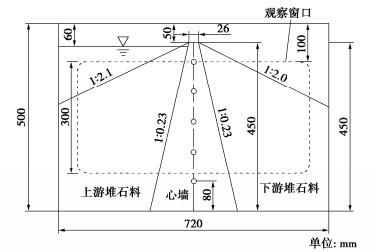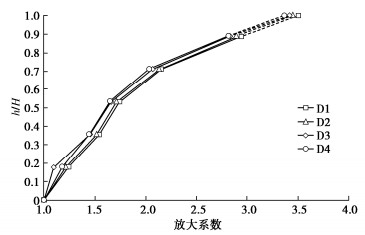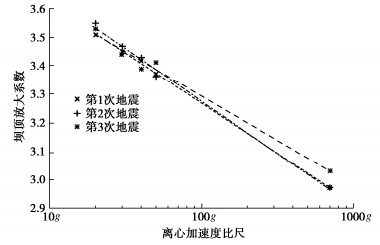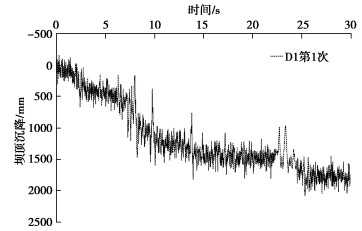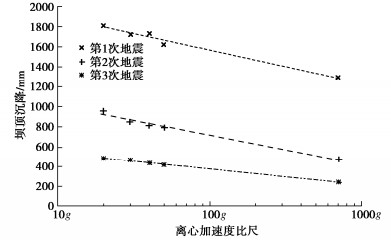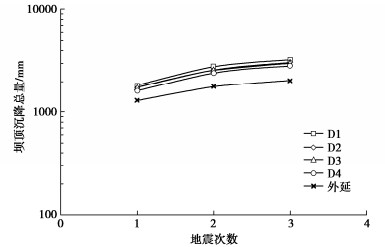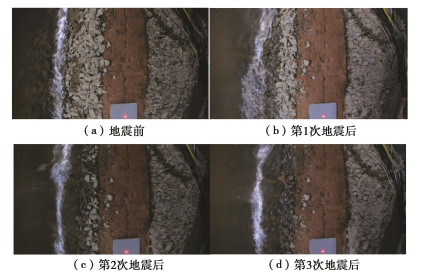Dynamic centrifuge modelling tests on seismic response of super-high core dams
-
摘要: 通过4组相同几何比尺、不同加速度比尺的土工离心机振动台模型试验,采用外延分析方法,研究了某特高心墙坝最大坝高断面在设计地震作用下的坝体地震反应、坝顶变形、地震破坏模式。试验结果表明:设计地震下坝顶地震加速度放大系数约为2.97~3.03;3次地震作用下坝顶的沉陷率分别约为0.41%,0.56%,0.64%;随着地震次数的增加,坝顶沉降也增加,但沉降增量迅速减小;心墙的沉陷量最小,且没有任何坍塌迹象,总体稳定;下游坝体受地震影响较小,仅观察到轻微沉陷;地震主要引起上游堆石料的沉陷,且主要发生在第1次地震,而后越来越小;3次地震过程导致上游堆石料沉陷至蓄水位附近;没有观察到明显的堆石滚落现象。试验揭示的破坏现象说明,需要对坝顶处的堆石料进行加固,避免心墙暴露。Abstract: In order to study the seismic behaviors of a super-high core dam under design seismic intensity, 4 dynamic centrifuge modelling tests are carried out. The models have the same scale and different centrifugal accelerations. Thus, the acceleration response, deformation and stability are analyzed through the extrapolation analysis. The crest acceleration amplification factor is 2.97~3.03. The crest settlement rate is 0.41%, 0.56% and 0.64%, respectively under 3 design earthquakes. The total crest settlement increases, but the incremental settlement decreases rapidly with the number of earthquakes. The settlements of the core, downstream rockfill and upstream rockfill are greater than the former. The core is stable and the settlement of the downstream rockfill is slight. The earthquakes cause the settlement of the upstream rockfill to the storage level. The aseismic measures are necessary to provide the core from exposure according to the test results.
-
Keywords:
- centrifuge shaking table /
- extrapolation analysis /
- super-high core dam /
- earthquake /
- failure mode
-
-
表 1 离心机振动台技术指标
Table 1 Parameters of centrifuge shaking table
离心加速度 80g 频率 20~200 Hz 最大振动加速度 20g 激振波型 正弦波 最大位移 5 mm 地震波 最大有效负载 500 kg 随机波 最大振动时间 3 s 振动方向 水平振动 -
[1] 王年香, 章为民. 土工离心模型试验技术与应用[M]. 北京: 中国建筑工业出版社, 2015. WANG Nian-xiang, ZHANG Wei-min. Centrifugal Model Test Technology and Its Application[M]. Beijing: China Architecture & Building Press, 2015. (in Chinese)
[2] 张雪东, 李纲, 魏迎奇, 等. 心墙堆石坝坝顶加筋措施的动力离心模型试验研究[J]. 中国水利水电科学研究院学报, 2018, 6(6): 591–597. https://www.cnki.com.cn/Article/CJFDTOTAL-ZGSX201806012.htm ZHANG Xue-dong, LI Gang, WEI Ying-qi, et al. Examining the performance of geo-grid reinforcement using dynamic centrifuge tests[J]. Journal of China Institute of Water Resources and Hydropower Research, 2018, 6(6): 591–597. (in Chinese) https://www.cnki.com.cn/Article/CJFDTOTAL-ZGSX201806012.htm
[3] 王年香, 章为民, 顾行文, 等. 高心墙堆石坝地震反应复合模型研究[J]. 岩土工程学报, 2012, 34(5): 798–804. https://www.cnki.com.cn/Article/CJFDTOTAL-YTGC201205005.htm WANG Nian-xiang, ZHANG Wei-min, GU Xing-wen, et al. Combined model for seismic responses of high core rock-fill dams[J]. Chinese Journal of Geotechnical Engineering, 2012, 34(5): 798–804. (in Chinese) https://www.cnki.com.cn/Article/CJFDTOTAL-YTGC201205005.htm
[4] 焦阳, 任国峰, 彭卫军, 等. 沥青混凝土心墙坝抗震加固离心机振动台试验研究[J]. 岩土工程学报, 2020, 42(增刊1): 167–171. doi: 10.11779/CJGE2020S1033 JIAO Yang, REN Guo-feng, PENG Wei-jun, et al. Aseismic measures for asphalt concrete core dams by dynamic centrifuge modelling tests[J]. Chinese Journal of Geotechnical Engineering, 2020, 42(S1): 167–171. (in Chinese) doi: 10.11779/CJGE2020S1033
[5] IAI S, TOBITA T, NAKAHARA T. Generalised scaling relations for dynamic centrifuge tests[J]. Géotechnique, 2005, 55(5): 355–362. doi: 10.1680/geot.2005.55.5.355
[6] 章为民, 王年香, 陈生水, 等. 地震动力离心模型试验外延分析方法: CN103728436A[P]. 2014-04-16. ZHANG Wei-min, WANG Nian-xiang, CHEN Sheng-shui, et al. Seismic Dynamic Centrifugal Model Test Extension Analysis Method: CN103728436A[P]. 2014-04-16. (in Chinese)
[7] CHEN S S, GU X W, REN G F, et al. Upgrades to the NHRI - 400 g-tonne Geotechnical Centrifuge[M]// London: Physical Modelling in Geotechnics. CRC Press, 2018: 495–500.
[8] 土工试验方法标准: GB/T 50123—2019[S]. 北京: 中国计划出版社, 2019. Standard for Geotechnical Testing Method: GB/T 50123—2019[S]. Beijing: China Planning Press, 2019. (in Chinese)



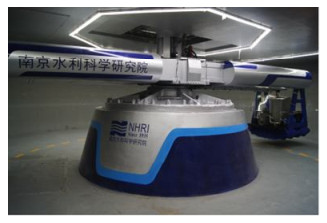
 下载:
下载:
